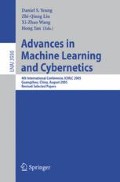Abstract
We investigate the use of independent component analysis (ICA) for speech feature extraction in digits speech recognition systems. We observe that this may be true for recognition tasks based on Geometrical Learning with little training data. In contrast to image processing, phase information is not essential for digits speech recognition. We therefore propose a new scheme that shows how the phase sensitivity can be removed by using an analytical description of the ICA-adapted basis functions. Furthermore, since the basis functions are not shift invariant, we extend the method to include a frequency-based ICA stage that removes redundant time shift information. The digits speech recognition results show promising accuracy. Experiments show that the method based on ICA and Geometrical Learning outperforms HMM in a different number of training samples.
Access this chapter
Tax calculation will be finalised at checkout
Purchases are for personal use only
Preview
Unable to display preview. Download preview PDF.
References
Amari, S.: Neural learning in structured parameter spaces—natural Riemannian gradient. In: Advances in Neural Information Processing System, vol. 9, pp. 127–133. MIT Press, Cambridge (1997)
Bell, A., Sejnowski, T.: An information-maximization approach to blind separation and blind deconvolution. Neural Comput. 7, 1129–1159 (1995)
Bell, A.J., Sejnowski, T.J.: Learning the higher-order structure of a natural sound. Network Comput. Neural Syst. 7, 261–266 (1996)
Bell, A.J., Sejnowski, T.J.: The ‘independent components’ of natural scenes are edge filters. Vision Res. 37(23), 3327–3338 (1997)
Box, G.E.P., Tiao, G.C.: Bayesian Inference in Statistical Analysis. Wiley, New York (1992)
Lee, J.H., Jung, H.Y., Lee, T.W., Lee, S.Y.: Speech feature extraction using independent component analysis. In: Proceedings of the International Conference Acoustics, Speech, Signal Processing, Istanbul, Turkey, June 2000, pp. 1631–1634 (2000)
Lee, J.-H., Lee, T.-W., Jung, H.-Y., Lee, S.-Y.: On the efficient speech feature extraction based on independent component analysis. Neural Process. Lett. 15(3), 235–245 (2002)
ShouJue, W.: A new development on ANN in China - Biomimetic pattern recognition and multi weight vector neurons. LNCS (LNAI), vol. 2639, pp. 35–43. Springer, Heidelberg (2003)
Shoujue, W., et al.: Multi Camera Human Face Personal Identification System Based on Biomimetic pattern recognition. Acta Electronica Sinica 31(1), 1–3 (2003)
Shoujue, W., et al.: Discussion on the basic mathematical models of Neurons in General purpose Neurocomputer. Acta Electronica Sinica 29(5), 577–580 (2001)
Wang, X., Wang, S.: The Application of Feedforward Neural Networks in VLSI Fabrication Process Optimization. International Journal of Computational Intelligence and Applications 1(1), 83–90 (2001)
Cao, W., Hao, F., Wang, S.: The application of DBF neural networks for object recognition. Inf. Sci. 160(1-4), 153–160 (2004)
Hyvärinen, A., Karhunen, J., Oja, E.: Independent Component Analysis. Wiley, New York (2001)
Cao, W.M.: Similarity index for clustering DNA microarray data based on multi-weighted neuron. In: Ślęzak, D., Yao, J., Peters, J.F., Ziarko, W.P., Hu, X. (eds.) RSFDGrC 2005. LNCS (LNAI), vol. 3642, pp. 402–408. Springer, Heidelberg (2005)
Cao, W.M., Hu, J.H., Xiao, G., et al.: Application of multi-weighted neuron for iris recognition. In: Wang, J., Liao, X.-F., Yi, Z. (eds.) ISNN 2005. LNCS, vol. 3497, pp. 87–92. Springer, Heidelberg (2005)
Cao, W.M.: The application of Direction basis function neural networks to the prediction of chaotic time series. Chinese Journal of Electronics 13(3), 395–398 (2004)
Author information
Authors and Affiliations
Editor information
Editors and Affiliations
Rights and permissions
Copyright information
© 2006 Springer-Verlag Berlin Heidelberg
About this paper
Cite this paper
Feng, H., Cao, W., Wang, S. (2006). Continuous Speech Recognition Based on ICA and Geometrical Learning. In: Yeung, D.S., Liu, ZQ., Wang, XZ., Yan, H. (eds) Advances in Machine Learning and Cybernetics. Lecture Notes in Computer Science(), vol 3930. Springer, Berlin, Heidelberg. https://doi.org/10.1007/11739685_102
Download citation
DOI: https://doi.org/10.1007/11739685_102
Publisher Name: Springer, Berlin, Heidelberg
Print ISBN: 978-3-540-33584-9
Online ISBN: 978-3-540-33585-6
eBook Packages: Computer ScienceComputer Science (R0)

